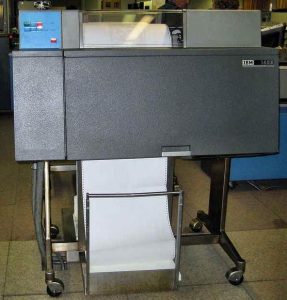IBM 1403 line printer
The line printer was introduced in 1959, for the 1400 series machines. It was an extremely long-lived creation, even surviving the 370 system. Interestingly, hammers did not strike the ink ribbon, but pressed the paper against the ink ribbon.
Use
High-volume, fast data printing and copying
It was used with virtually every IBM computer until the end of the 1970s.
Structure
Essential parts of the printer:
- hammer row
- character string
- ribbon roll and transport mechanism
- paper feed mechanism
The number of characters that could be printed on a line was determined by the number of hammers in the hammer row (120 or 132).
Printable characters were contained in the 240-character, replaceable printer chain. The basic set included 48 different characters: 26 uppercase letters, 10 digits, and 12 punctuation marks (& , . – $ * / % # @ ≠ ⌑).
By replacing the string, different types of characters (lowercase, italics, Greek letters, etc.) could be printed.
Operation
When printing, the character string ran continuously, horizontally, in front of the paper, and the ink ribbon ran the full width of the line, vertically, between the character string and the paper. Unlike traditional typewriters, the row of hammers was located behind the paper, and when the desired character passed a position, the corresponding hammer — through the ink ribbon — struck the paper against the printing chain, so that the image of the current character appeared on the paper.
The hammers were operated by a powerful electromagnet, through whose coil the excitation current passed at just the right moment. This process took place in a few milliseconds, after which the hammer was automatically pulled back to its resting position by a spring.
The printer was available in 600 lpm and 1100 lpm versions. The printing speed was also affected by the number of times the character set could be placed on the character string. If necessary, the string could be changed in a matter of minutes.
Up to 6 copies of accordion-folded paper were fed vertically by gears that gripped perforations on the edge. The number of line feeds and refeeds, as well as the starting position within a line, were determined by a programmable “carriage control tape”, allowing different formats to be printed, even on different paper sizes.
There was also a two-color ribbon.
Program set
The printer was controlled by the computer's operating system.
Many unique programs have been written for different print images.
Interesting examples include the Mona Lisa picture made with a printer, or the music-making program, a rhythm machine, that uses the knock of the printer's hammers.
Historical curiosities
The printer is the same age as the — also epoch-making — ballpoint typewriter. Its success is due to its simpler and more flexible design compared to previously used printers, as well as its character string design.
Over time, various additional devices were made for it: perforation removers, sheet cutters, folders, envelope makers, etc. A common banking application was, for example, the checkbook-making addition, but we also know of bookbinding or copy-binding applications.
Resources
General description, as well as a video demonstration of the structure and operation: IBM 1403 line printer
Historical, technical and model data: IBM 1403 (English)
Created: 2016.07.20. 22:39
Last modified: 2025.02.19. 16:47

